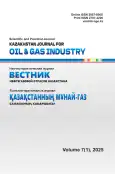Analysis of the Application of Proppant Hydraulic Fracturing in the Development of Gas Condensate Fields with Low Permeable Reservoirs of the C₁v₁ and C₁sr Deposits
- Authors: Yussubaliyev R.A.1, Tulenbayeva B.R.1, Konys A.B.1
-
Affiliations:
- KazNIGRI
- Issue: Vol 7, No 1 (2025)
- Pages: 66-78
- Section: Oil and gas field development and exploitation
- URL: https://journal-vniispk.ru/2707-4226/article/view/293584
- DOI: https://doi.org/10.54859/kjogi108780
- ID: 293584
Cite item
Full Text
Abstract
Background: The ongoing shortage of natural gas in the country necessitates enhanced efficiency in gas field development. Alongside domestic gas consumption, the demand for higher production volumes, particularly from low-permeability reservoirs, further emphasizes the relevance of this study.
Aim: To optimize the production in fields with low-permeability reservoirs through proppant hydraulic fracturing (HF) to increase the permeability of formations and improve well productivity.
Materials and methods: The study’s object is the gas condensate field X, located in the Moyynkum trough of the Shu-Sarysu depression in the Zhambyl region. During the study, a comprehensive analysis was conducted on the efficiency of refracturing operations, with a specific focus on proppant tonnage. As a result, a methodology for optimizing the parameters of refracturing was proposed. This methodology involves adjusting the volume of injected proppant to alter the geometry of fractures and enhance well productivity. Furthermore, a novel approach to adapting hydraulic fracturing techniques for conditions with a high risk of fluid accumulation in the wellbore has been developed. Unlike conventional solutions, this approach introduces a comprehensive production stabilization strategy that incorporates mechanized fluid removal methods, such as coiled tubing, foam-inhibiting check valves, and plunger elevators.
Results: It was determined that maintaining the initial injection volume during repeated HF operations does not significantly enhance the gas flow rate. An analysis of the post-fracturing data confirmed the effectiveness of the applied strategy, as evidenced by changes in the gas-condensate factor and the stabilization of flow rates. Additionally, soluble fibers were utilized for the first time in some wells during the HF process. The analysis indicated that their application yielded positive outcomes, including improved fracture conductivity and increased well productivity, suggesting that this technology holds promise for future implementation.
Conclusion: The findings of the study indicate that it yields higher gas production gains compared to refracturing. This highlights the significance of precise timing and careful selection of proppant volume to optimize the effectiveness of refracturing. In the X field, HF continues to be a crucial intervention for enhancing the productivity of new wells. It is advisable to conduct pre- and post-operation pressure recovery curve analyses to monitor impacts and refine the technology used. Considering the reservoir characteristics and potential pressure interferences, the operation’s design and the proppant volume must be meticulously planned to achieve the best possible outcomes.
Full Text
##article.viewOnOriginalSite##About the authors
Renat A. Yussubaliyev
KazNIGRI
Email: yussubaliyev.r@kaznigri.kz
ORCID iD: 0009-0007-3525-1984
Kazakhstan, Atyrau
Bayan R. Tulenbayeva
KazNIGRI
Email: b.tulenbayeva@kaznigri.kz
ORCID iD: 0009-0007-9454-2490
Kazakhstan, Atyrau
Akbayan B. Konys
KazNIGRI
Author for correspondence.
Email: konysakbayan@gmail.com
ORCID iD: 0000-0001-7240-3595
Kazakhstan, Atyrau
References
- Shirkovskiy AI. Razrabotka i ekspluatatsiya gazovykh i gazokondensatnykh mestorozhdenyi. Moscow: Nedra; 1979. 297 p. (In Russ).
- Zheltov Y.P. Razrabotka neftyanykh mestorozhdenyi. Moscow: Nedra; 1986. 332 p. (In Russ).
- Sheraz A, Atta MК, Ijaz А,Osama HK. Enhancing Recoveries from a Low Permeable Gas-Condensate Reservoir through Hydraulic-Fracturing & EOR Technologies. PAPG/SPE Pakistan Section Annual Technical Conference and Exhibition; 2016 Nov 21–23; Islamabad, Pakistan. Available from: https://onepetro.org/SPEPATS/proceedings-abstract/16PATC/16PATC/SPE-185310-MS/192882.
- Chufrin VA, Sergeyev IV. Povisheniye effektivnosti razrabotki mestorozhdeniy s nizkopronitsaemymy kollektorami. Vestnik neftyanoy i gazovoy promyshlennosti. 2020;7:45–52. (In Russ).
- Mambetov ZS, Medvedev KS. Analiz effektivnosti mnogozonnogo gidrorazryva plasta v usloviyakh nizkopronitsaemykh kollektorov. Voprosy nauki i obrazovaniya. 2018’;26(38): 98–107.
- Smith J, Anderson P. Advancements in Proppant Technologies for Enhanced Gas Condensate Recovery. Journal of Petroleum Science and Engineering. 2022;210:45–61.
- Stabinskas AP, Sultanov SK, Mukhametshin VS, et al. Evolution of Hydraulic Fracturing Fluid: from Guar Systems to Synthetic Gelling Polymers. SOCAR Proceedings Special Issue. 2021;2:172–181. doi: 10.5510/OGP2021SI200599.
- Zhang K, Liu X-F, Wang D-B, et al. A review of reservoir damage during hydraulic fracturing of deep formations. Petroleum Science. 2024;21:384–409. doi: 10.1016/j.petsci.2023.11.017.
- Barati R, Liang J-T. A Review of Fracturing Fluid Systems Used For Hydraulic Fracturing of Oil and Gas Wells. Journal of Applied Polymer Science. 2014;131(16). doi: 10.1002/app.40735.
- Buriak I. Improvement of Bottom-Hole Cleaning After Hydraulic Fracturing on Urengoy Oil and Gas Condensate Field. SPE Arctic and Extreme Environments Technical Conference and Exhibition; 2013 Oct 15–17; Moscow, Russia. Available from:https://onepetro.org/SPEAEEC/proceedings-abstract/13AEEC/All-13AEEC/SPE-166861-MS/174033.
- Alsultan AH, Shaoul JR, Park J, Zitha PLJ. Case Study of Condensate Dropout Effect in Unconventional Gas/Condensate Reservoirs with Hydraulically Fractured Wells. SPE International Hydraulic Fracturing Technology Conference & Exhibition; 2022 Jan 11–13; Muscat, Oman. Available from: https://onepetro.org/SPEIHFT/proceedings-abstract/20IHFT/2-20IHFT/D021S007R004/475667.
- Gazdiyev AI. Opyt provedeniya povtornogo GRP na gazokondensatnykh skvazhinakh. Bureniye i neft. 2023;7:112–125. doi: 10.62994/2072-4799.2024.70.79.008.
Supplementary files
















